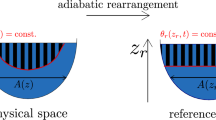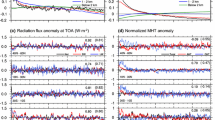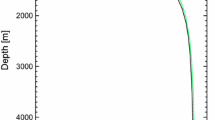Abstract
Anomaly-diffusing energy balance models (AD-EBMs) are routinely employed to analyze and emulate the warming response of both observed and simulated Earth systems. We demonstrate a deficiency in common multi-layer as well as continuous-diffusion AD-EBM variants: They are unable to, simultaneously, properly represent surface warming and the vertical distribution of heat uptake. We show that this inability is due to the diffusion approximation. On the other hand, it is well understood that transport of water from the surface mixed layer into the ocean interior is achieved, in large part, by the process of ventilation—a process associated with outcropping isopycnals. We, therefore, start from a configuration of outcropping isopycnals and demonstrate how an AD-EBM can be modified to include the effect of ventilation on ocean uptake of anomalous radiative forcing. The resulting EBM is able to successfully represent both surface warming and the vertical distribution of heat uptake, and indeed, a simple four-layer model suffices. The simplicity of the models notwithstanding, the analysis presented and the necessity of the modification highlight the role played by processes related to the down-welling branch of global ocean circulation in shaping the vertical distribution of ocean heat uptake.




Similar content being viewed by others
Notes
e.g., because of their computational intensity, ESMs themselves are never run long enough to directly assess climate sensitivity.
In order to exclude the possibility that our results are due to poor parameter tuning in the EBMs we consider, we apply a Bayesian statistical framework and Monte Carlo sampling to widely explore the space of parameter uncertainties.
We note that the intention of the CMIP abrupt 4×CO2 forcing experiment is one of calibration and diagnosis of equilibrium climate sensitivity since post-industrial surface warming itself is compatible with a wide range of climate sensitivities.
All experiments are run with each of the three forcings under consideration (abrupt4x, 1%, and historical), and the quantities of interest (QoI) are the SAT with each forcing and the 0–700-m and 700–2000-m OHC with historical forcing. While we also considered radiative non-equilibrium (RN), those results are left out for brevity.
In the two-layer EBM, warming of the ocean extends only to the depth of the two layers. That is, there is no warming below the depth of the second layer. Furthermore, the depth of the top layer should be thought of as roughly equivalent to the globally averaged mixed-layer depth (O (100 m); ≪ 700 m) The 0–700-m and 700–2000-m warming is obtained using linear interpolation.
When a number of the variations mentioned are considered in combination, and with a large number of layers, calibration of the resulting model can sometimes lead to, e.g., the top-layer depth being different from the a priori estimate of around 70 m. In such cases, we performed a companion experiment in which the top-layer depth is fixed at 70 m, and so on.
References
Aldrin M, Holden M, Guttorp P, Skeie RB, Myhre G, Berntsen TK (2012) Bayesian estimation of climate sensitivity based on a simple climate model fitted to observations of hemispheric temperatures and global ocean heat content. Environmetrics 23(3):253–271
Balmaseda MA, Trenberth KE, Källén E (2013) Distinctive climate signals in reanalysis of global ocean heat content. Geophys Res Lett 40(9):1754–1759
Bodman RW, Jones RN (2016) Bayesian estimation of climate sensitivity using observationally constrained simple climate models. Wiley Interdiscip Rev Clim Chang 7(3):461–473
Bryan K, Lewis L (1979) A water mass model of the world ocean. J Geophys Res Oceans 84(C5):2503–2517
Budyko MI (1969) The effect of solar radiation variations on the climate of the earth. Tellus 21(5):611–619
Cheng L, Trenberth KE, Fasullo J, Boyer T, Abraham J, Zhu J (2017) Improved estimates of ocean heat content from 1960 to 2015. Sci Adv 3(3):e1601, 545
Domingues CM, Church JA, White NJ, Gleckler PJ, Wijffels SE, Barker PM, Dunn JR (2008) Improved estimates of upper-ocean warming and multi-decadal sea-level rise. Nature 453(7198):1090–1093
Friend A (2011) Response of earth’s surface temperature to radiative forcing over AD 1–2009. J Geophys Res Atmos 116(D13112). https://doi.org/10.1029/2010JD015143
Geoffroy O, Saint-Martin D, Ribes A (2012) Quantifying the sources of spread in climate change experiments. Geophys Res Lett 39(24)
Geoffroy O, Saint-Martin D, Olivié D J, Voldoire A, Bellon G, Tytéca S (2013) Transient climate response in a two-layer energy-balance model. Part I: analytical solution and parameter calibration using CMIP5 AOGCM experiments. J Clim 26(6):1841–1857
Gnanadesikan A (1999) A simple predictive model for the structure of the oceanic pycnocline. Science 283(5410):2077–2079
Goodwin P (2012) An isopycnal box model with predictive deep-ocean structure for biogeochemical cycling applications. Ocean Model 51:19–36
Gregory JM (2000) Vertical heat transports in the ocean and their effect on time-dependent climate change. Clim Dyn 16(7):501–515
Held IM, Winton M, Takahashi K, Delworth T, Zeng F, Vallis GK (2010) Probing the fast and slow components of global warming by returning abruptly to preindustrial forcing. J Clim 23(9):2418–2427
Hoffert MI, Callegari AJ, Hsieh CT (1980) The role of deep sea heat storage in the secular response to climatic forcing. J Geophys Res Oceans 85(C11):6667–6679
Houghton JT, Meira Filho LG, Griggs DJ, Maskell K (1997) An introduction to simple climate models used in the IPCC second assessment report. WMO, UNEP
Johansson DJ, O’Neill BC, Tebaldi C, Häggström O (2015) Equilibrium climate sensitivity in light of observations over the warming hiatus. Nat Clim Chang 5 (5):449–453
Knutti R, Hegerl GC (2008) The equilibrium sensitivity of the earth’s temperature to radiation changes. Nat Geosci 1(11):735–743
Levitus S, Antonov JI, Boyer TP, Baranova OK, Garcia HE, Locarnini RA, Mishonov AV, Reagan J, Seidov D, Yarosh ES et al (2012) World ocean heat content and thermosteric sea level change (0–2000 m), 1955–2010. Geophys Res Lett 39(10)
Marshall DP, Zanna L (2014) A conceptual model of ocean heat uptake under climate change. J Clim 27(22):8444–8465
Mauritsen T, Stevens B, Roeckner E, Crueger T, Esch M, Giorgetta M, Haak H, Jungclaus J, Klocke D, Matei D et al (2012) Tuning the climate of a global model. J Adv Model Earth Syst 4(3)
Meinshausen M, Raper SC, Wigley TM (2011a) Emulating coupled atmosphere-ocean and carbon cycle models with a simpler model, MAGICC6–part 1: model description and calibration. Atmos Chem Phys 11(4):1417–1456
Meinshausen M, Smith SJ, Calvin K, Daniel JS, Kainuma M, Lamarque J, Matsumoto K, Montzka S, Raper S, Riahi K et al (2011b) The RCP greenhouse gas concentrations and their extensions from 1765 to 2300. Clim Chang 109 (1–2):213
Murphy J (1995) Transient response of the Hadley Centre coupled ocean-atmosphere model to increasing carbon dioxide. Part III: analysis of global-mean response using simple models. J Clim 8(3):496–514
Nadiga B, Urban N (2016) Dependence of inferred climate sensitivity on the discrepancy model, climate informatics. In: Proceedings of the 6th international workshop on climate informatics: CI 2016 NCAR technical notes NCAR/TN-529+PROC, https://doi.org/10.5065/D6K072N6:29--32
North GR, Cahalan RF, Coakley JA (1981) Energy balance climate models. Rev Geophys 19(1):91–121
Padilla LE, Vallis GK, Rowley CW (2011) Probabilistic estimates of transient climate sensitivity subject to uncertainty in forcing and natural variability. J Clim 24 (21):5521–5537
Pedlosky J (2013) Ocean circulation theory. Springer Science & Business Media, Berlin
Raper S, Cubasch U (1996) Emulation of the results from a coupled general circulation model using a simple climate model. Geophys Res Lett 23(10):1107–1110
Raper S, Gregory JM, Osborn T (2001) Use of an upwelling-diffusion energy balance climate model to simulate and diagnose a/OGCM results. Clim Dyn 17 (8):601–613
Raper SC, Gregory JM, Stouffer RJ (2002) The role of climate sensitivity and ocean heat uptake on AOGCM transient temperature response. J Clim 15(1):124–130
Schneider SH, Thompson SL (1981) Atmospheric CO2 and climate: importance of the transient response. J Geophys Res Oceans 86(C4):3135–3147
Sellers WD (1969) A global climatic model based on the energy balance of the earth-atmosphere system. J Appl Meteorol 8(3):392–400
Talley LD (2011) Descriptive physical oceanography: an introduction. Academic, New York
Taylor KE, Stouffer RJ, Meehl GA (2012) An overview of cmip5 and the experiment design. Bull Am Meteorol Soc 93(4):485–498
Tziperman E (1986) On the role of interior mixing and air-sea fluxes in determining the stratification and circulation of the oceans. J Phys Oceanogr 16(4):680–693
Urban NM, Keller K (2010) Probabilistic hindcasts and projections of the coupled climate, carbon cycle and atlantic meridional overturning circulation system: a Bayesian fusion of century-scale observations with a simple model. Tellus A 62(5):737–750
Wigley T, Raper S (1992) lmplications for climate and sea level of revised IPCC emission scenarios. Nature 357:28
Acknowledgments
BTN would like to thank W. Riley Casper for the help in identifying the zero entries of \(\widetilde {A}\) in Eq. 10. All of the data used in this article has been previously archived and may be obtained as follows: The Levitus ocean heat content data may be obtained from the the National Oceanographic Data Center at https://www.nodc.noaa.gov. CMIP5 data may be obtained from one of the Earth System Grid Federation nodes, e.g., https://esgf-node.jpl.nasa.gov. The SAT data may be obtained from https://crudata.uea.ac.uk/cru/data/temp-erature. The historical radiative forcing and the RCP8.5 scenario forcing may be obtained from (Meinshausen et al. 2011b). We acknowledge the World Climate Research Programme’s Working Group on Coupled Modelling, which is responsible for CMIP, and we thank the climate modeling groups for producing and making available their model output. For CMIP, the US Department of Energy’s Program for Climate Model Diagnosis and Intercomparison provides coordinating support and led development of software infrastructure in partnership with the Global Organization for Earth System Science Portals.
Author information
Authors and Affiliations
Corresponding author
Additional information
Publisher’s Note
Springer Nature remains neutral with regard to jurisdictional claims in published maps and institutional affiliations.
Electronic supplementary material
Below is the link to the electronic supplementary material.
Rights and permissions
About this article
Cite this article
Nadiga, B.T., Urban, N.M. Improved representation of ocean heat content in energy balance models. Climatic Change 152, 503–516 (2019). https://doi.org/10.1007/s10584-018-2333-9
Received:
Accepted:
Published:
Issue Date:
DOI: https://doi.org/10.1007/s10584-018-2333-9




